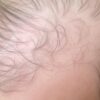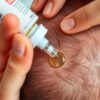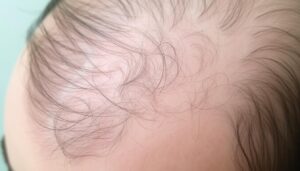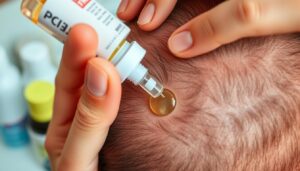Are you dealing with hair loss and unsure which treatment to choose? Finasteride comes in topical and oral forms, making it hard to decide. You might wonder if topical finasteride is effective or if oral finasteride is better.
When thinking about your options, you might also consider scalp Mmcropigmentation. It can be used with finasteride to get the best results. But first, let’s look at how finasteride works.
Key Takeaways
- Finasteride is a medication used to treat hair loss, available in both topical and oral forms
- Understanding the differences between finasteride topical vs oral is crucial in making an informed decision
- Does oral finasteride work better than topical finasteride, or vice versa?
- Finasteride topical vs oral has different absorption rates and bioavailability
- It’s essential to consider the potential side effects of finasteride when choosing a treatment option
- Hair loss solution: scalp micropigmentation (SMP)
Understanding Finasteride: How Does It Work?
Finasteride is a medication primarily used to treat hair loss and prostate enlargement by inhibiting the conversion of testosterone to dihydrotestosterone (DHT). DHT is a more potent androgen that contributes to hair follicle shrinkage and prostate growth. Understanding how finasteride works involves delving into the biochemical interactions at play.
The drug targets the enzyme 5-alpha-reductase, effectively blocking its ability to convert testosterone into DHT. This reduction in DHT levels helps in sustaining hair growth in individuals experiencing androgenetic alopecia while also alleviating symptoms associated with benign prostatic hyperplasia.
Hair Loss Causes
Hair loss is a common concern that affects millions of people worldwide, and its causes can be complex and multifaceted. Genetic factors play a significant role; for many individuals, male or female pattern baldness is a hereditary condition that can manifest as thinning hair or receding hairlines.
Hormonal changes are also a key contributor, often triggered by life events such as pregnancy, menopause, or medical conditions like polycystic ovary syndrome (PCOS). Stress, both physical and emotional, can exacerbate hair loss, leading to conditions like telogen effluvium, where hair follicles enter a resting phase and hair falls out more easily.
Comparing Side Effects
When looking at finasteride for hair loss, it’s key to compare side effects and safety. Does topical finasteride have less side effects than oral finasteride? This makes topical finasteride a better choice for many.
Whether is topical or oral finasteride better depends on your health and medical history. Topical finasteride is safer because it skips the digestive system. This lowers the chance of side effects throughout the body. Always talk to a doctor about the risks and benefits of each option.
Oral finasteride can cause:
- Decreased libido
- Erectile dysfunction
- Increased risk of prostate cancer
Topical finasteride can cause:
- Itching
- Irritation
Which Is More Effective?
When considering hair loss treatment options, many individuals find themselves weighing the efficacy of topical finasteride against its oral counterpart. A common concern that arises is, Is topical finasteride as effective as oral?
Oral finasteride is usually more effective than topical finasteride for treating hair loss. When you ingest it, it works throughout your whole body to lower the levels of a hormone called DHT, which is linked to hair loss. Topical finasteride, which you apply directly to your scalp, can help reduce DHT in the area, but it’s not as strong as the oral version. However, some people prefer topical finasteride because it may cause fewer side effects since it doesn’t affect the whole body as much. If you are looking for a non-invasive treatment that is efficient, scalp micropigmentation may be for you.
Hair Loss Solution: Scalp Micropigmentation
Scalp micropigmentation has emerged as a revolutionary solution for individuals grappling with hair loss. This non-invasive treatment involves the application of specialized pigments to the scalp, creating the illusion of fuller, thicker hair. Unlike more traditional methods such as hair transplants, which can be invasive and expensive, scalp micropigmentation offers a quicker, more efficient approach to addressing the visual aspects of hair loss. Those who undergo the procedure often report high satisfaction levels, particularly due to the immediate and aesthetically pleasing results that mimic the appearance of a closely shaved head.
Making the Right Choice for You
Although Finsteraride is an option for hair loss, if you are seeking a non-invasive, immediate solution to hair loss, scalp micropigmentation provides a powerful alternative that complements treatments like finasteride, enhancing overall results.
Come visit us at ScalpMasters! We specialize in providing customized solutions for hair loss, including expert scalp micropigmentation treatments. If you’re ready to take control of your hair restoration journey, we invite you to schedule a consultation with our experienced team.
Are you ready to start your journey? Contact us today to schedule a consultation and to learn more about how we can help you achieve your hair restoration goals. Don’t wait—start your transformation now!










